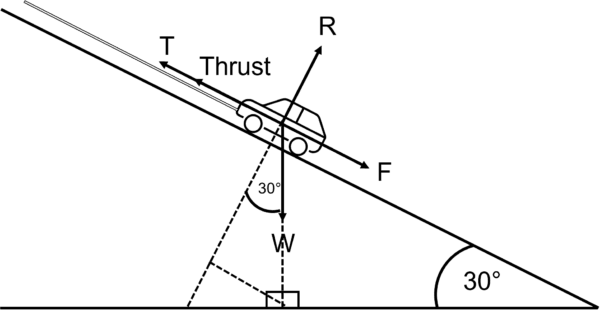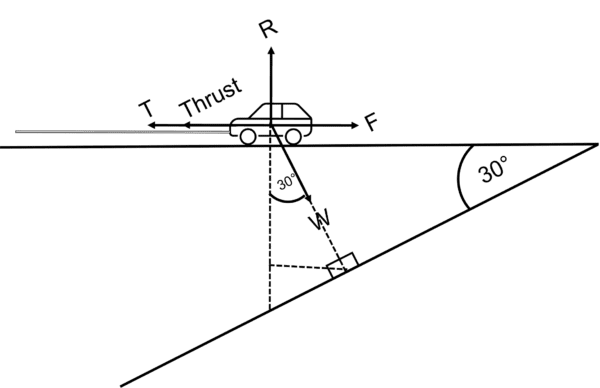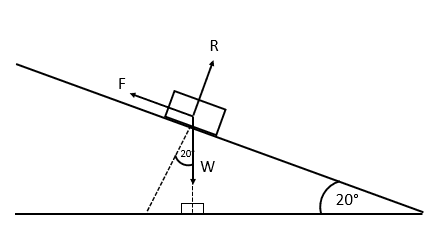Friction
Friction Revision
Friction
In the Forces section, we mentioned that friction was calculated by the equation F \leq \textcolor{red}{\mu} R, where \textcolor{red}{\mu} is known as the coefficient of friction, which has no units. As a general rule of thumb, the rougher a surface is, the higher its coefficient of friction.
We also have the term limiting friction, when friction is at its maximum. This is shown when F = \textcolor{red}{\mu} R.
Make sure you are happy with the following topics before continuing.
Fundamentals
Example: Here’s a box on a flat surface with two people pushing and pulling in the same direction.

Let’s now say that the weight of the box, W, is 100\text{ N}, and that the friction is limiting (i.e. applying any more force in T or Thrust will cause the box to accelerate). Say, also, that the friction F is 50\text{ N}.
Then we have the normal reaction force R = 100\text{ N}.
Since F = \textcolor{red}{\mu} R, the coefficient of friction, \textcolor{red}{\mu} = \dfrac{50}{100} = 0.5.
Note:
By definition, the coefficient of friction \mu is such that \textcolor{red}{\mu} \geq 0. It is usually, but not always, less than 1.
Friction on a Tilted Plane
Example: Here’s a 1500 \text{ kg} car being towed up an incline at an angle of 30\degree. Say the slope has a coefficient of friction \textcolor{red}{\mu} = 0.4. What would be the required combined force of the tension in the rope, T, and the thrust from the car? Assume the car is travelling at constant velocity up the hill.

First, adapt this system by rotating it, to visualise the perpendicular forces a little more easily.

Perpendicular to F, we have R = W\cos 30°.
W = 1500 \times 9.8 = 14700\text{ N}, so R = 12730.57\text{ N}
So, parallel to F, we have T + \text{Thrust} = F + W\sin 30°.
By F_{max} = \textcolor{red}{\mu} R, the limit of friction is F_{max} = 5092.23\text{ N}
Since we have W and F_{max}, we can see that the minimum thrust and tension required to move the car up the slope is 5092.23 + W\sin 30° = 12442.23\text{ N}.
Friction Example Questions
Question 1: A box of mass m\text{ kg} lays on a flat surface, with no vertical force applied. Find an expression for the potential friction force, F, in terms of \mu, m and g.
[2 marks]
We have F \leq \mu R.
Since no other vertical forces are applied, we have W = R.
We also have W = mg.
Therefore, we have the expression
F \leq \mu mg
Question 2: A brick is sliding down a rough plane inclined at 20°.
Given that its acceleration is 0.2\text{ ms}^{-2}, what is the coefficient of friction?
[4 marks]

Resolving perpendicular to F:
R = W\cos 20° = mg\cos 20°
Resolving parallel to F:
Resultant Force = F_{res} = ma = 0.2m
We also have
F_{res} = W\sin 20° - \mu R
= mg\sin 20° - \mu mg\cos 20°
So,
g\sin 20° - \mu g\cos 20° = 0.2
Giving
\mu = \dfrac{9.8\sin 20° - 0.2}{9.8\cos 20°} = 0.342\text{ (to }3\text{ dp)}
Question 3: A 10\text{ g} particle travels along a flat surface at 80\text{ms}^{-1}. It slows to rest in 20\text{ seconds}. What is the coefficient of friction?
[4 marks]
For v = u + at, we have
0 = 80 + 20a\\a = \dfrac{-80}{20} = -4\text{ ms}^{-2} horizontally.
From Newton’s Second Law, F = ma = 0.01 \times -(-4) = 0.04\text{ N}.
Vertically, we have R = 0.01 \times 9.8 = 0.098\text{ N}
With no other horizontal forces acting on the system, we assume the friction is limiting, so
\mu = \dfrac{0.04}{0.098} = 0.408\text{ (to }3\text{ dp)}






